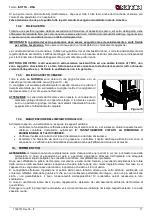
Termo
ISOTTA – DSA
7199701 Rev.05 – EN
21
Your chimney sweep must be informed regarding the installation of the thermoheating stove, so that he can check the
correct connection to the flue and the level of efficiency of the latter.
Modifications cannot be made to the appliance.
Before installation, check that your floor can support the weight of the thermoheating stove.
ATTENTION: assure that the appliance is on a perfect level and that the diameter of the fumes outlet pipe is
that requested.
Several stoves cannot be connected to the same chimney.
Have your local chimney sweep check the chimney connection and the sufficient flow of air for combustion in the
place of installation.
The diameter of the opening for connection to the chimney must correspond with the diameter of the flue pipe. The
opening must have a wall connection for the insertion of the outlet pipe and must also have a washer.
The
DSA thermo stove models, can be installed in both an OPEN expansion VESSEL system (see chapter 3.1) and a
CLOSED expansion VESSEL system (see chapter 3.2).
3.1.
OPEN expansion VESSEL system
It is
COMPULSORY that the OPEN expansion Tank system is provided with:
1.
OPEN EXPANSION Tank: which has a capacity of 10% of total water content of thermo-product and of the
installation. This is installed at the highest point of the system, at least 2 m over the radiator that is at the highest
level.
2.
SAFETY PIPE: connects the delivery of the thermoheating stove with the upper part of the vessel, described in
point 1, by the shortest route without descending or siphoned tracts. The safety pipe must have a minimum
section of 1”gas.
3.
LOAD PIPE : which connects the bottom of open expansion tank with the return pipe of installation. The
minimum diameter must be ¾” gas. All those parts must no have for any reason
meditate intercept bodies that
could accidentally exclude them and must be placed in rooms which are protected from frost. On the contrary, if
they freeze, the boiler body could break or even explode. In case of frost placing it will be right to add a proper
percentage of antifreeze liquid to the water of installation in order to delete the whole problem. In no way there
must be water circulation in the open expansion tank between the safety and loading pipe. This would cause the
water oxygenation and the consequent corrosion of thermo-product and installation in a very short time.
4.
THERMAL DISCHARGE VALVE which is a further positive safety that prevents the boiling even when electric
energy is missing. It is made by a valve cover like a pressure safety valve which differs from it as it opens by
reaching a pre-calibrated temperature (normally at 94 – 95°C) and unload hot water from the installati on delivery.
This will be replaced with as much cold water coming from the open expansion tank loading pipe of open tank by
draining away the excessive heat.
5.
SAFETY VALVE of 1,5bar: the maximum operating pressure allowed for the system is 1.5bar (equal to 15m of
water column), greater pressures can cause deformations and damage to the boiler body.
6.
OTHER SAFETY DEVICES required by the Regulation in force on the matter.
7.
CIRCULATION PUMP: It would be better to install it on the return in order to avoid that it could disconnect itself
at very high water temperatures but checking that it does not drive water in the open expansion tank otherwise it
should cause a continuous water oxygenation with consequent, fast corrosion of boiler body. It must be not to
avoid a forced circulation in the open expansion tank. Furthermore it must be electrically connected to a
thermostat or a electronic control unit that can be purchased with the thermo-fireplace as
OPTIONAL part.
8.
AUTOMATIC THERMOSTATIC MIXING VALVE – (see chapter 3.3)
IMPORTANT: temperature safety sensors must be in place on the machine at a distance no greater than 30 cm from
the flow connection of the thermo-product.
Whenever the thermo products lack a device, those missing can be installed on the thermo product flow pipe, within a
distance no greater than 1m from the thermo product.
ATTENTION: For no reason must the fire be ignited before the system has been completely filled with water;
doing this would lead to serious damage of the entire structure. The system must be filled by means of the
loading pipe directly from the open vessel tank in a way to prevent an excessive water pressure network
deforming the body of the thermoheating stove.
The system must be kept constantly full of water even during the periods when the use of the thermoheating stove is
not requested. During the winter, inactivity must be faced with the addition of antifreeze.
















































